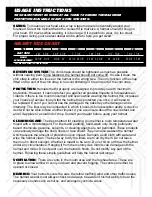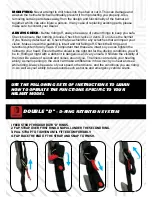
RETENTION SYSTEM
: The chin straps should be tightened as much as possible
without causing pain. Once fastened, the helmet should not come off. In case it does, the
chin strap is either too loose or the helmet is the wrong size.
The only function of the snap
fitted on the end of the chin strap is to avoid fluttering of the end part of the chin strap.
PROTECTION
:
Helmets that fit properly are designed to provide you with maximum
protection. However, it cannot protect you against all possible impacts or foreseeable ac-
cidents. If there is too much movement and space while wearing the helmet, this increases
your chance of serious injury. After the helmet has protected you once, it will need to
be replaced. Even if you cannot see the damage to the naked eye the damage can be
internally. The liner may be compacted in which it loses its full absorption ability. A crack or
dent will not be able to take another impact. If you are unsure about the one-contact rule
and if it applies to a small hit or drop. Consult your dealer before using your helmet.
CLEANING/CARE
:
The best method for cleaning your helmet is room temperature water
mixed with a mild detergent. For liners and padding, hand-wash only. Using petroleum
based chemicals, gasoline, solvents, or cleaning agents are not permitted. These products
can seriously damage the shell, liners or face shield. They can also weaken the helmet
which lessens the amount of protection upon impact. Dampen a soft cloth with water and
wipe the helmet clean. The best way to dry the liners are to air dry them. Do not leave
them out in direct sunlight. A helmet is meant to be worn. Do not sit on or throw the helmet
under any circumstance. Hanging it from the motorcycle’s mirrors can damage both the
helmet and mirror. Do not paint over the helmet’s finish. Do not modify any part of the
helmet. Following these simple guidelines will help the helmet last longer.
VENTILATION
:
There are vents in the mouth area and the forehead area. These are
in place to allow airflow to cool you down and prevent fogging. The vents can either be
opened or closed.
HEARING
:
Your helmet covers the ears, therefore muffling wind and other traffic noises.
The helmet wearer must always check and always be aware of his/her ability to hear the
necessary sounds such as horns, and emergency vehicle sirens.
HELMET SIZE CHART
ALL MEASUREMENTS DONE IN INCHES
SIZE
XS
SM
MD
LG
LX
2XL
HAT SIZE
6 1/2" - 6 5/8"
6 3/4" - 6 7/8"
7" - 7 1/8"
7 1/4" - 7 3/8"
7 1/2" - 7 5/8"
7 3/4" - 7 7/8"
HEAD
MEASUREMENT
20 7/8" - 21 1/4"
21 5/8" - 22"
22 1/2" - 22 7/8" 23 1/4" - 23 5/8"
24" - 24 3/8"
24 3/4" - 25 1/4"
USAGE INSTRUCTIONS
THIS HELMET MUST BE wORN AT ALL TIMES TO ENSURE THE MAXIMUM
PROTECTION AVAILABLE IN ANY GIVEN SITUATION.
SIZING
:
To measure your head size, wrap a tape measure horizontally around your
forehead. Select the helmet that is the closest fit to that size. A helmet should fit snug on
your head. If it moves while wearing, it is too large. If it is painful to wear, it is too small.
For proper sizing, your nearest dealer will be able to help you get sized.

























